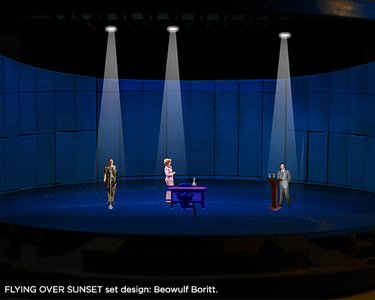Asked to describe briefly his scenic design for Flying Over Sunset, Beowulf Boritt replied: “It’s an open cylinder of space.” He’s not being vague: When I observe the current tech rehearsals for the show, which starts previews March 12th, that’s exactly the shorthand I would assign to what has been conjured up for the Beaumont. Of course, Boritt’s splendid design is so much more than an open cylinder, and if I don’t spring too many details that’s because we’re still relatively early in the process of reveal.
I’ll leave it to Boritt himself to share what can be said. “The impetus for the design came from early conversations I had with James Lapine” – the production’s book writer and director – “and others. We asked ourselves: what does LSD, which our main characters take, do to a brain? The design for the Beaumont space is open, so that it can stand in general for the imagination or the brain. We go from there.”
I asked Boritt about the relative predominance of the color blue in the production. “There’s no specific thematic reason,” he answered. “It’s just that blue is a malleable color which allows us to layer many things onto the space. Also, the story has scenes in Malibu and Connecticut, areas where the ocean or water figures.”
The set for Flying Over Sunset marks quite a contrast with the marvelous whirligig Boritt created for LCT’s Act One, also a Lapine production, for which Boritt won a Tony award. In both cases, however, Boritt got a chance to work in the Beaumont, which he called “my favorite theater in New York, maybe in the world. It is both epic and intimate.” The audience member who arrives for Flying Over Sunset may glimpse a vast arena, but rest assured that the intimate will soon sail into view.
“There are massive walls,” Boritt said, “but the walls can move, to push the action downstage. And it’s essential that we do that, because even though Flying Over Sunset occupies a large canvas, it’s essentially an intimate musical: ten actors.”
Boritt and I discussed some of the technical effects that, I suspect, will delight audiences who see the show. (Again, no details – yet.) That led me to asking him to name the greatest technical changes that have happened in scenic design since he began his career, a career that has included, on Broadway, Come From Away and The 25th Annual Putnam County Spelling Bee, and, off-Broadway, more than 100 shows, including the recent hit Fiddler on the Roof (in Yiddish).
“3-D modeling and 3-D printing,” Boritt explained, “have resulted in big changes to how designers work. I still may start the process by playing around with cardboard, creating the shapes of the design. But soon enough the more recent technologies take over.” Boritt added: “Another big change involves projection. That technology has gotten much less expensive compared to just a few years ago, so small theaters can take advantage of it.”
Even with the new tools, Boritt said that his definition of scenic design has not changed fundamentally. “I still call it ‘the transformation of space over time.’”
The timeframe of Flying Over Sunset is the 1950s. “One of the reasons we are using abstract shapes in the design,” Boritt said, “is that in that era abstraction was a big story in art and architecture. Even the Beaumont itself” – designed by Finnish architect Eero Saarinen – “has links to that aesthetic. It’s such a joy for me to work in this theater again.”
Brendan Lemon is the editor of lemonwade.com
